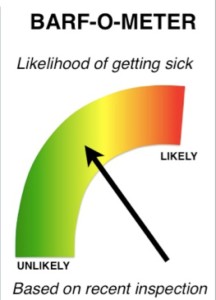According to this editorial, it seems like the Guelph-area public health unit can take extra steps to make the community more aware of food safety issues at local eateries.
 Wellington-Dufferin-Guelph Public Health’s latest records show it has recently flagged 152 area eateries with food safety violations that could cause food poisoning.
Wellington-Dufferin-Guelph Public Health’s latest records show it has recently flagged 152 area eateries with food safety violations that could cause food poisoning.
However, unless someone went through the health unit’s posted database for such issues, there would be no public notification surrounding these findings. What’s more, there is no obligation for local eateries to even draw the public’s attention to the existence of recent health unit inspection results, let alone make available, on-site, a report of such findings relating to their food operation.
The health unit touted its present, public food safety inspections database related to local eateries when the online tool was launched in 2013. It suggested the system was a big improvement over what had been in place in this regard. That was true. What it replaced was an opaque system for the public that required requests for the food safety records of eateries to be made to the health unit for its release, on its timing.
However, even when the Check Before You Choose program emerged, it lagged behind best practices elsewhere in the public health field — even in southern Ontario.
 Since 2001, Toronto Public Health’s DineSafe has been a leader in this sector. Where the Guelph-area health unit obliges citizens to do their research and dig for potentially concerning restaurant food safety records, the Toronto system makes eateries prominently post the results of the latest health unit inspections on-site. What’s more, the reports are colour coded, so it can be seen at a glance whether an eatery received a pass (green), a yellow report (conditional approval), or a red (closure order) in their latest inspection.
Since 2001, Toronto Public Health’s DineSafe has been a leader in this sector. Where the Guelph-area health unit obliges citizens to do their research and dig for potentially concerning restaurant food safety records, the Toronto system makes eateries prominently post the results of the latest health unit inspections on-site. What’s more, the reports are colour coded, so it can be seen at a glance whether an eatery received a pass (green), a yellow report (conditional approval), or a red (closure order) in their latest inspection.
The Toronto system has its critics. Some fault DineSafe as a “name and shame” initiative that may also give a false sense of food safety security to diners. However, DineSafe’s introduction coincided with a period where the rate of food safety compliance jumped at local eateries and stayed higher.
A version of the system has since been adopted in several other regional health unit venues and in other international jurisdictions.
